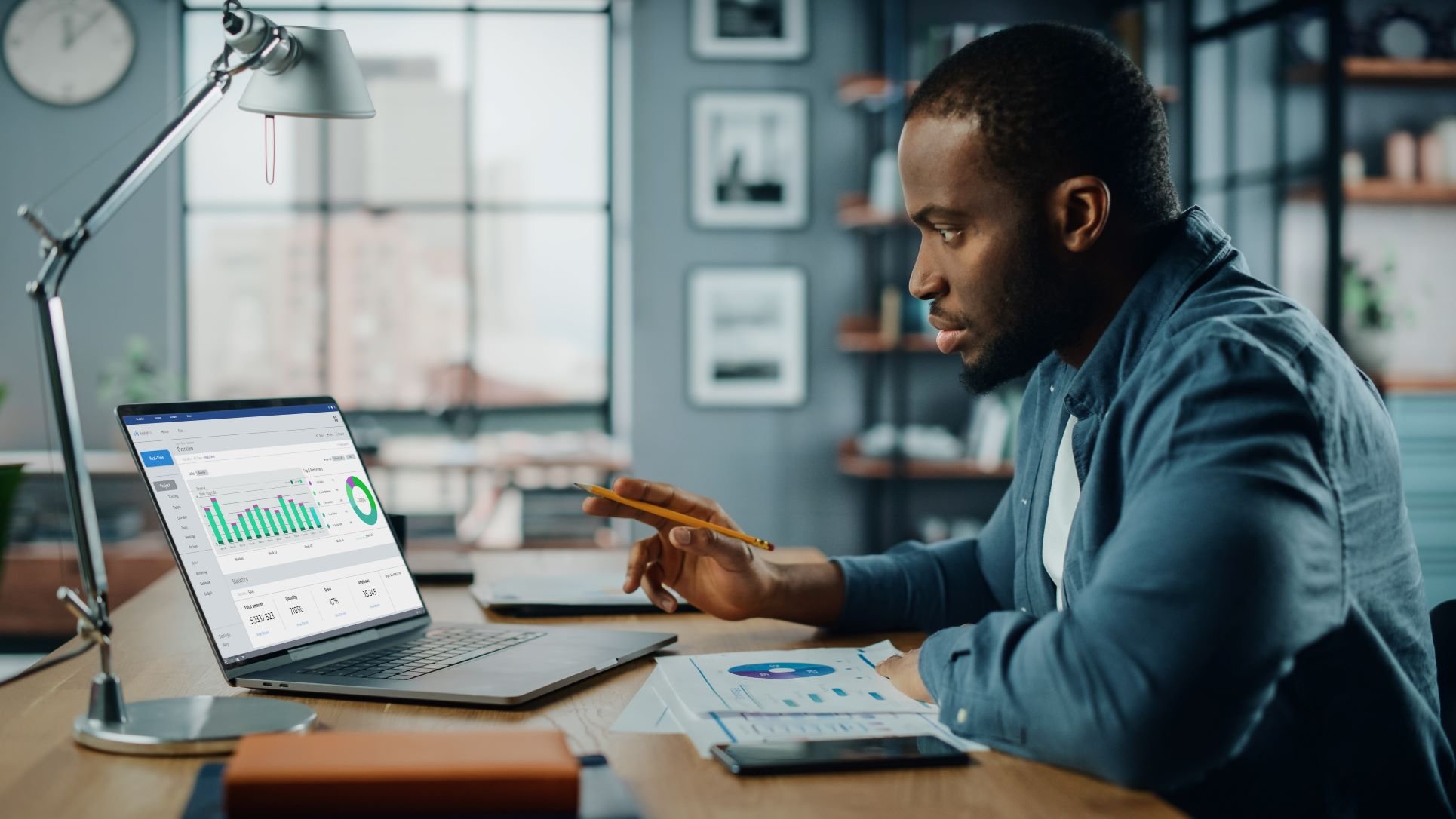Indiana native Donald Brown knows a thing or two about running a business.
He graduated with a master's degree in computer science in the early 1980s (when an exciting new field called "artificial intelligence" was just beginning to emerge), then founded a company named Interactive Intelligence. The business embraced cloud computing analytics to monitor interactions within call centers, giving companies better insight into their customers' behavior. Interactive was eventually acquired in 2016 for $1.4 billion, delivering an impressive return for shareholders along the way.
Many entrepreneurs might be tempted to throw in the towel after running a business for two decades and then leading it through a successful multibillion-dollar acquisition. But Brown had more fuel in his tank and went on to get another master's degree in biotechnology. (He also has a medical degree, is bilingual, and has eight kids; yes, seriously.)

Image source: Getty Images.
The next step
For investors, it's worth keeping tabs on what visionary and ambitious leaders like Brown are up to. So I was very interested to learn that he has founded a new business called LifeOmic.
LifeOmic aims to drive better health outcomes for patients. It's building a cloud-based platform that will allow patients, doctors, researchers, and other professionals to share information collaboratively. By working together, they can discover correlations between data points, enabling a new era of personalized healthcare. Think of it as the place where life sciences, computer sciences, and artificial intelligence converge.
I recently spoke with Brown about his new venture, while also soliciting his thoughts about the current state of American healthcare.
One insight he offered is that several of the information systems available in healthcare today are created with the healthcare provider in mind, rather than the patient. Electronic healthcare records offered by Cerner, Epic, and others are largely focused on biometric readings or billing reimbursement, which on their own aren't very valuable or useful to patients. But by providing easier-to-understand insights (especially with a social or gaming component included), it's possible to empower patients and consumers to take charge of their own health. Good behavior (such as exercise, diet, or fasting) and an understanding of personal risk factors (such as genetic predispositions) could go a long way in improving the quality -- and length -- of your life.
Of course, consumer-focused healthcare is attracting a lot of competitive attention. FitBit, Apple, and Alphabet (GOOGL +1.07%) (GOOG +1.11%) have all recently taken an interest in wearable devices and/or life sciences. But large tech companies have also recently acquired some scars related to data privacy, which could make it difficult for patients to trust them with their most personal health and genetic information. One key advantage for LifeOmic is that it's a smaller, independent company that has direct partnerships with several of the country's top medical and academic institutions. This could provide a less biased, more interconnected ecosystem that more accurately predicts potential health conditions.
In our conversation, Brown described the current state of healthcare, the importance of social components, and how he views the competition in the space. He also described his approach to learning new things, explained how the Gartner (IT +0.46%) Hype Cycle manifests, and offered several new technologies that should be on investors' radar (including a fascinating new field called senolytics).
A transcript of our interview, recorded on April 18, is provided below.
Transcript
Don Brown, CEO and founder of LifeOmic: So we started off doing this, which is a lot. We built some really nice APIs; we made this super-scalable, very reliable; [we] got HIPAA and HITRUST certifications. But what we started to realize: We got asked more and more about patient data, patient-acquired data. There's kind of a third leg to the stool that's not represented with the whole genome sequence and electronic medical records.
And in finishing up grad school, I had really gotten into the practice of intermittent fasting. And so I said, "Tell you what, let's build a little app for intermittent fasting. This'll kind of scratch an itch that I have." I was sharing information with friends and family, and thought it'd be kind of a cool way to communicate. And it would kind of establish the plumbing, the mobile-side plumbing that ultimately would allow us to connect to mobile devices for patient-acquired data, an increasing telemetry that we're walking around with, even more advanced versions like the Oura Ring. There are wireless devices for just about everything now. So we wrote this little mobile app for fasting.
We had over a million active fasting sessions on our app. It's been wonderful in a number of regards. It certainly has spread the name recognition of the company. We're getting lots of leads coming in, as a result of just a free app. But it's really helped us prove the scalability and reliability of our platform, that we now have over a million weekly users. We're rushing headlong, creating a next-generation, more general health and wellness app that incorporates nutrition, activity, mindfulness, [and] sleep, along with the metabolic switching that comes with intermittent fasting. And trying to gamify that into a number of points people can earn every day, building organizational tools so that organizations can create their own private circles for wellness programs, or any number of others.
For us, that ends up providing this cloud platform that can be used for secure storage and aggregation of all these types of data. On these mobile devices we can take all the information coming in from wearables, as well as push surveys out to those patients. And collect disease-specific information, family history, all of that sort of stuff. It completes the whole picture for researchers, that they can do a research study and reach out to patients, gather more information from them. But now we're talking with major organizations like the American Cancer Society and even the state of Indiana, looking to roll this out as a general health and wellness app -- in the case of Indiana, to all six million citizens of the state.
[We're] trying to push out the science-proven, but personalized, ways that we can make use of whatever we know -- whether it's just 23andMe basic genetic information, or answers about family history, or a whole genome sequence. We can take all that information and then create very personalized recommendations back out to patients. That you ought to be going in for a ... cardiac exam, based upon your genetic background, your family risk factors; this $200 calcium score could be the difference between life and death for you. Or you've got two copies of the APOE e4 gene that predispose you to Alzheimer's.
These are the things that you need to be doing now. There's a whole new frontier coming in medicine. We're just excited to be part of it.
Simon Erickson, lead advisor of Motley Fool Explorer: I've done some of the consumer tests. I've done the Ancestry.com; I've done a pharmacogenomic test. So I'm contributing some of that out there, on my own interest in this.
But are you finding any sensitivities with more of the patient data or even the clinical data? There's always the interoperability debate: Is this proprietary, or are we able [share data to work together]? Are there any sensitivities of the data that you're gathering from everywhere?
Brown: So far, nothing that's been any sort of barrier for us. For better or worse, we're all used to having our data flow out there. The main thing is to convince people that this is for them, that they're getting something out of it. So the failure of a lot of healthcare apps has been that they've been totally one-sided. Here's a place where you can go and see your electronic medical records, or get lab results, or something; that's fine, that's cool. But you have no incentive to use that app on a daily basis. There's no ongoing value you're getting from that. So we felt it was important to provide gamification so that you've got some incentive, you want to earn points.
How do I earn points? Well, if I eat more fruits and vegetables, I earn points. If I move my butt, I earn points. If I try to learn meditation, I earn some points. If I just don't eat between dinner and breakfast, that's fasting; I earn points.
You're gently guided toward these things that are all very scientifically well established: that eating more broccoli will do you good; putting down the fork after dinner and not nibbling until breakfast will do you good. We know these things. We're doing that.
We added a strong social component so that people can get set up. I've got a family circle that I set up with my kids. We compare notes about fasting or whatever we're doing. There can be circles for work, circles for men who run, circles for women who row, or whatever it might be. That social component is really important. People want to get validation from others they care about, and encouragement, say, when they're having a tough time sticking to a diet. Or trying to do their first 16-hour fast, or something like that.
We've been able to generate a lot of excitement, as I say, with the state of Indiana. They were launching this program called ALL-IN, that today is a website, where they try to collect healthcare information about citizens in the state of Indiana. But in July, we're going to launch this with them so that they're giving something fun to every citizen that becomes a conduit into the state healthcare system for collecting information, for finding participants in research studies, all those sorts of things. But that's providing day-to-day value back out to the patients themselves.
Erickson: It's like the Peloton [an internet-connected exercise bike]. The same thing where riding a bicycle, now you've got a social interaction with others. This makes you want to do it more, it gets people doing things they already knew they should be doing.
But now it gamifies it. It adds the social element.
Brown: That's exactly right.
Erickson: And the data too, right? Don, I mean now you actually have numbers that say, "Hey, this is what you're at risk of. This is what we really recommend." You know you should be eating your broccoli and moving around already. But specifically for you, based on your genome, this is making it more real.
Brown: Yeah. It really is accelerating pretty rapidly, with the pharmacogenomics and our knowledge of how your genetic background affects your metabolism of different drugs. We're starting to gain that knowledge in so many different areas. We've just tried to build a very general platform, and it really doesn't matter whether it's collecting your whole genome sequence, or information about your microbiome that we're realizing is increasingly important. It can aggregate all those sorts of data, push out personalized recommendations -- and especially in a research setting, even a clinical research setting. Maybe you're suffering from gout, and they can put you in a study with 1,000 other men [who] are suffering from gout, and look at your medication histories and your genetic backgrounds, and steer you toward some sort of therapy that is more likely to work for you. Rather than adopt a classic, trial-and-error approach that medicine is known for.
Erickson: I want to chat a little bit about the business side of this too. A lot of companies are interested in this space too. I mean Google's got a life-sciences division. Apple's now got the HealthKits. Even companies like Fitbit are trying to build an ecosystem around the data, like biometrics on patients.
I saw on your site that you guys are partnering with a lot of companies out there. But how are you actually making money, and how do you distinguish between partner and competitor in the field?
Brown: The latter part is just about impossible. It's the classic competition that you often see in the tech industry -- just can't worry about it too much. Some differences about us are that early on I gave a percentage of the company to the [Indiana University] School of Medicine. In return I asked that we have access to all their faculty members, and we've got a blanket license to all their intellectual property. So it's a good two-way deal. We work closely with them on a number of these cancer efforts. For one thing, I think the big companies are kind of at a disadvantage these days.
There's not a lot of trust for Google. Especially Google, [but] for any of the big tech companies. So there are advantages in being a smaller company, especially affiliated with a trusted organization like an academic medical school. We're finding that to be a major advantage.
Then for us, the whole mobile thing is -- I won't say a lark -- but we don't need the mobile aspect of our business, or any direct-to-consumer part, to take off [and] be a successful company. We're licensing our platform to academic medical institutions, like IU [Indiana University], we're working with Purdue. We're working with a number of others around the country. That really was our initial focus. Then this mobile, direct-to-consumer thing that has unexpectedly taken off, we're still trying to figure out what we do with that. Right now it's just a free app we're having fun with. We think it does make our platform for larger organizations more attractive.
Because now they can bring consumers directly in for surveying, for consent management, for a lot of those aspects. But we're now getting calls out of the blue from some of the major internet companies that have identified intermittent fasting as one of those rapidly growing health areas, and obviously understand our role there.
So we'll see. To be honest, [I] don't know how or if we're going to monetize that side of the business. Right now, as I say, we're just generating subscription revenue from these larger customers that use us as a platform.
Erickson: Well Don, you're the guy that I would be betting on, even if those companies have more people and larger institutions. For anyone listening here to this audio, Don has got a bachelor's in physics. He then at the same time got a master's in computer science and a medical doctorate degree. And then went back years later and got a master's also in biotechnology. Don, you've probably got one of the most complete resumes of anyone I've ever talked to in my life.
That's amazing. Congratulations.
Brown: Little bit nerdy, but it's fun. I love this stuff.
Erickson: On top of that, you also had at Interactive [Intelligence] -- his previous company -- a 99% approval rating on Glassdoor, which is how employees rate their leaders. So it's fantastic that you've not only compiled all this knowledge, but then have also shown the leadership to lead people on your vision.
My second-to-last question to you is actually more of a fun one. How do you actually go about learning new things? How do you go about saying, "I want to get a master's in biotechnology now," or a medical doctorate degree? How do you actually start this process?
Brown: Well, it starts simply by caring. By being interested, by being passionate about something. I've got eight kids, they've gone through college and moaned at different times about, "I hate this one subject I'm taking." One thing I emphasize to them is we are exquisitely evolved to tune out anything we don't care about; our brains are really, really good at that. So when you sit there and say, "I hate calculus," your brain is reading that loud and clear. Like, "Well this calculus stuff obviously this is not important. I'm not going to retain it." So you find yourself just fighting against yourself. Learning anything always begins by caring. By convincing yourself that this is important, and even if it's kind of hard.
And it was hard at 60, 59, whenever I started to go back to earn a master's at Johns Hopkins -- pretty good school. But I found that I cared enough, and I ended up having 10 classes over the course of that degree, and being the top student every time in those classes. Just because I care. I have a little bit of a competitive streak, but it was just cool stuff. And my mind was just racing with possibilities during each one.
Erickson: That is really cool, and that rings true with me because I have a 15-month-old daughter here at home. She's getting in to everything. She's starting to discover the world around her and ask lots of questions. I will always encourage caring and getting into things she doesn't know about.
Brown: Well yeah, that's exactly right. It is curiosity, it's caring about something that just leads you to push on through. Even if on the face of it it's silly, or odds are stacked against you, or whatever.
But the other thing I think these days, is the sources of information through Coursera, or YouTube videos. There's so many sources out there that it makes it much easier, I think, to learn than maybe the first time around for me, when I was stuck with a 20-pound textbook. And if I didn't understand their explanation, there was nowhere else to go. So you read it 20 times until it starts to sink in. The resources out there today are just tremendous.
Erickson: And the last question I have for you, Don, as somebody who lives and breathes this every day: Our audience is individual investors, people that are really interested in this space too, but they might not be experts in life sciences. What would you recommend, or maybe a couple of things that you think we should watch or pay attention to, to figure out what's really happening in the industry that you live and breathe every day?
Brown: I certainly think stem-cell therapies. They've been hamstrung a little bit initially. But it started off with the discovery that embryonic stem cells, cells from embryos, could become any of the roughly 200 tissue types in the body. Then a lot of ethical concerns around that one. But I think it was around 2008 that a Japanese scientist named [Shinya] Yamanaka discovered that he could take a regular cell, a differentiated mature cell like a skin cell, and treat it with just four factors, and it would revert back to an embryonic [inaudible] potent state. It's been 10 years now, and now we're starting to understand that process really well: how we can recreate stem-like cells, and then how we can push them down different lineage paths to become [inaudible], or neurons, or cardiac cells, or whatever. That's a big one.
Another...I mean gene therapy reminds me of AI. My original graduate work in computer science was in artificial intelligence. Then it became a dirty word for a while. There's the old Gartner Hype Cycle where there's technology [that] comes out, it's going to solve the world's problem; it doesn't, and so it falls into this trough of disillusionment. But you come back 10 years later and it's in everything -- maybe not with as much fanfare the second time around. So gene therapy is very much in that category. I think it was back in the [19]80s that there was a super hope of gene therapy, being able to insert genes to correct deficits.
Well, that was the primary approach back then. But there were some unexpected cancers that resulted, that cast a pall over the whole field. Now, with our ability with CRISPR to go in and make very fine-tuned edits, as well as other sorts of advancements in the field: There was a company called Mustang Bio that just yesterday announced a gene therapy that cured a fundamental immunodeficiency known as "bubble boy" disease, that you may have heard of. There have been a few of these lately. So, gene therapy.
Another one is RNAi: RNA interference. If you're familiar with Alnylam -- OK, so it sounds like you know a little bit about this one. That's a big area, realizing that we can go in with little bits of RNA and very precisely interfere with the production of a given protein.
Another area I'm really interested in is senolytics. As we age, we all accumulate a number of cells that are called senescent cells, that just become blobs. They don't divide anymore, so they shut down division. But they continue to live. They don't die and go away like a good cell, but go into senescence. They just spew out a bunch of inflammatory toxic chemicals that over time lead to a condition that's become known as "inflammaging." It looks like one of the main drivers behind [not only] a lot of the chronic diseases of aging, but the effects of aging itself.
There was a Dutch guy up at [the] University of Wisconsin, three or four years ago, who shook everybody up when he engineered some mice so that at any point in their life, when he wanted, he could give...feed them something and kill all their senescent cells. Just wondering; he didn't know. He thought [it would] probably kill the mouse too. That was his guess as to what would happen. But amazingly, what happened was, it killed the oldness in the mouse and the mouse started running again like a young mouse.
Erickson: Interesting.
Brown: They've replicated that experiment; they've done some very similar experiments in rhesus monkeys now. So there are several companies that are racing to build senolytics -- these drugs that you could take one, maybe, a couple times a year when you're 60 and not for another 10 years. But they will selectively kill off these senescent cells. Again, it's probably going to be some trough of disillusionment here when effects aren't quite as dramatic as promised. But they seem to be very promising, and as a way to help deal a little bit better with some of the underlying conditions that lead to these diseases of aging. Like cancer, and heart disease, and osteoporosis, and Parkinson's, and a bunch of others that they're probably at least, in part, linked to this process of development of senescent cells.
Those would be some quick ideas.
Erickson: It's interesting to see how the industry has progressed from trying to control the process. You mentioned RNAi, you're trying to stop the message, your RNA, the development of protein cells -- pull it back to upstream at the genome, and [you] actually can reedit the genome now.
Recently at South by Southwest, I just went to see several conversations about the bioethical debate brewing about CRISPR and gene editing. Here in the U.S. there's so many regulations about [how] you can't do this, it's a very fine line. Less so in China; there's now genetically engineered babies over there. Middle East, the same way too. There's a little bit less sensitivity about doing some of those experiments. So the technology's out there, like you said. It's going to be very interesting on how it's controlled.
Brown: It's not very hard to use, so it's a genie that's pretty difficult to put back in the bottle. If somebody changes the germ line, that gets passed along the generations, then you've got a potential arms race of a kind we've never seen before.
Erickson: Genie's out of the bottle now, right?
Brown: It's exciting but scary, like all new technologies.
Erickson: That's what keeps it interesting, to say the least. Well, Don, I really appreciate the time.
Brown: My pleasure. Nice talking to you.








